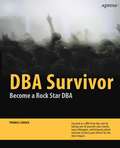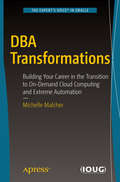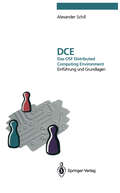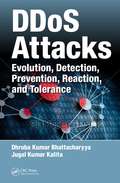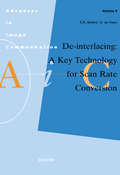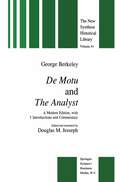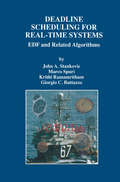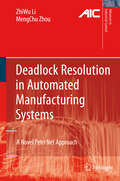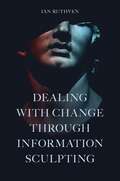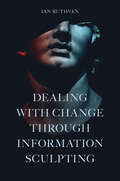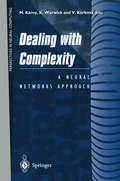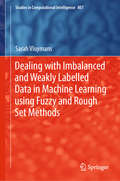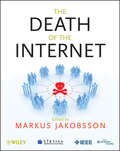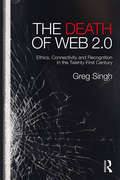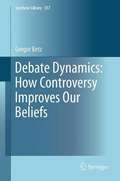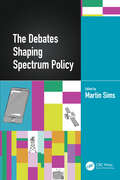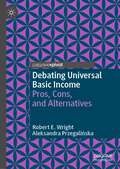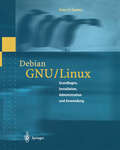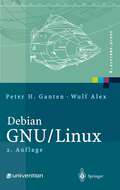- Table View
- List View
DBA Survivor: Become a Rock Star DBA
by Thomas LaRockDBA Survivor is a book to help new database administrators understand more about the world of database administration. More and more people are moving into the DBA profession, and many are looking for a getting-started guide. Blogs are written about how to be an exceptional DBA and what to do in your first 100 days. This book takes a different approach, injecting some humor into helping you understand how to hit the ground running, and most importantly how to survive as a DBA. And it’s not just survival that matters. Author Thomas LaRock wants much more for you than mere survival. He wants you to have excellence, competence, visibility, confidence, and service. These are the traits and characteristics of DBAs who truly succeed and become respected in their profession. Don’t settle for just muddling through your job each day. Strive to excel. Aim to make a difference, for your clients, and for your colleagues. Focuses on the soft skills that distinguish truly exceptional DBAs Takes a humorous approach to keep readers engaged Written by a SQL Server "Most Valuable Professional" and board member of PASS
DBA Transformations: Building Your Career in the Transition to On-Demand Cloud Computing and Extreme Automation
by Michelle MalcherAdapt your career as a database administrator to the changing industry. Learn where the growth and demand for DBA talent are occurring and how to enhance your skill set. Creating databases, providing access, and controlling data are no longer the focus. What matters now is managing and monitoring the systems that provide access to users of the data.This book will help you formulate a plan for development and change to remain valuable in the face of radical new developments around cloud computing, containerized databases, and automation of routine tasks. The playing field is shifting rapidly with the development of technologies and software enhancements that automate and even eliminate many traditional aspects of the DBA job. DBA Transformation helps you redirect your attention and skills as a DBA to areas such as design and development of the containers and cloud environments on which automation depends. You will be encouraged to build soft skills as well as to focus on technical pain points such as data security that are of even greater importance now that so much corporate data is in cloud-based systems that are accessible from the Internet at large. What You'll LearnEmbrace and profit from rapid shifts in the database industryRecognize where growth and demand for talent are occurring Create a personal transformation plan to help you navigate the changesPivot your career toward more interesting skills and responsibilitiesWho This Books Is ForWorking database professionals who are interested in keeping their careers relevant as well as building their careers and making them stronger in the face of dramatic changes that are being driven by trends toward cloud computing and containerization
DCE: Sicherheit für die Praxis
by Horst MehlDer Autor beschreibt erstmals eine vollständige Gesamtlösung, die in der Industrie zur Einführung eines DCE-Systems als Security-Middleware für Client-Server-Systeme entwickelt wurde. Aus der Praxis heraus werden konkrete Fragestellungen, Alternativen und Design-Entscheidungen vorgestellt. Im Mittelpunkt steht die mit DCE in heterogenen Systemen umsetzbare applikatorische Sicherheit.
DDoS Attacks: Evolution, Detection, Prevention, Reaction, and Tolerance
by Dhruba Kumar BhattacharyyaDDoS Attacks: Evolution, Detection, Prevention, Reaction, and Tolerance discusses the evolution of distributed denial-of-service (DDoS) attacks, how to detect a DDoS attack when one is mounted, how to prevent such attacks from taking place, and how to react when a DDoS attack is in progress, with the goal of tolerating the attack. It introduces typ
De-interlacing: A Key Technology for Scan Rate Conversion (ISSN #Volume 9)
by E.B. Bellers G. de Haan'To interlace or not to interlace' is a hot issue currently. Traditionally interlace has been part of the video standard as it reduces the transmission and display demands, while hardly affecting the perceived quality of the pictures.With the current explosion of new video formats due to emerging technologies as multimedia PC's, videotelephony and flat matrix display the question whether or not interlace is a relict from the past is more relevant than ever.This book provides a broad overview of advanced motion estimation and de-interlacing techniques to enable a profound scientific basis for answering the above question. An extensive evaluation of the algorithms, including many screen photographs is an imt part of the book. But also system questions, such as whether interlace is a good choice in combination with modern video compression methods (MPEG), and which currently would be the optional choice for a display format are extensively treated.The combination of scientific profoundness and completions, with the focus on practical hot issues, makes the book unique in its kind.
De Motu and the Analyst: A Modern Edition, with Introductions and Commentary (The New Synthese Historical Library #41)
by G. BerkeleyBerkeley's philosophy has been much studied and discussed over the years, and a growing number of scholars have come to the realization that scientific and mathematical writings are an essential part of his philosophical enterprise. The aim of this volume is to present Berkeley's two most important scientific texts in a form which meets contemporary standards of scholarship while rendering them accessible to the modern reader. Although editions of both are contained in the fourth volume of the Works, these lack adequate introductions and do not provide com plete and corrected texts. The present edition contains a complete and critically established text of both De Motu and The Analyst, in addi tion to a new translation of De Motu. The introductions and notes are designed to provide the background necessary for a full understanding of Berkeley's account of science and mathematics. Although these two texts are very different, they are united by a shared a concern with the work of Newton and Leibniz. Berkeley's De Motu deals extensively with Newton's Principia and Leibniz's Specimen Dynamicum, while The Analyst critiques both Leibnizian and Newto nian mathematics. Berkeley is commonly thought of as a successor to Locke or Malebranche, but as these works show he is also a successor to Newton and Leibniz.
Deadline Scheduling for Real-Time Systems: EDF and Related Algorithms (The Springer International Series in Engineering and Computer Science #460)
by John A. Stankovic Marco Spuri Krithi Ramamritham Giorgio C ButtazzoMany real-time systems rely on static scheduling algorithms. This includes cyclic scheduling, rate monotonic scheduling and fixed schedules created by off-line scheduling techniques such as dynamic programming, heuristic search, and simulated annealing. However, for many real-time systems, static scheduling algorithms are quite restrictive and inflexible. For example, highly automated agile manufacturing, command, control and communications, and distributed real-time multimedia applications all operate over long lifetimes and in highly non-deterministic environments. Dynamic real-time scheduling algorithms are more appropriate for these systems and are used in such systems. Many of these algorithms are based on earliest deadline first (EDF) policies. There exists a wealth of literature on EDF-based scheduling with many extensions to deal with sophisticated issues such as precedence constraints, resource requirements, system overload, multi-processors, and distributed systems. Deadline Scheduling for Real-Time Systems: EDF and Related Algorithms aims at collecting a significant body of knowledge on EDF scheduling for real-time systems, but it does not try to be all-inclusive (the literature is too extensive). The book primarily presents the algorithms and associated analysis, but guidelines, rules, and implementation considerations are also discussed, especially for the more complicated situations where mathematical analysis is difficult. In general, it is very difficult to codify and taxonomize scheduling knowledge because there are many performance metrics, task characteristics, and system configurations. Also, adding to the complexity is the fact that a variety of algorithms have been designed for different combinations of these considerations. In spite of the recent advances there are still gaps in the solution space and there is a need to integrate the available solutions. For example, a list of issues to consider includes: preemptive versus non-preemptive tasks, uni-processors versus multi-processors, using EDF at dispatch time versus EDF-based planning, precedence constraints among tasks, resource constraints, periodic versus aperiodic versus sporadic tasks, scheduling during overload, fault tolerance requirements, and providing guarantees and levels of guarantees (meeting quality of service requirements). Deadline Scheduling for Real-Time Systems: EDF and Related Algorithms should be of interest to researchers, real-time system designers, and instructors and students, either as a focussed course on deadline-based scheduling for real-time systems, or, more likely, as part of a more general course on real-time computing. The book serves as an invaluable reference in this fast-moving field.
Deadlock Resolution in Automated Manufacturing Systems: A Novel Petri Net Approach (Advances in Industrial Control)
by ZhiWu Li MengChu ZhouDeadlock problems in flexible manufacturing systems (FMS) have received more and more attention in the last two decades. Petri nets are one of the more promising mathematical tools for tackling deadlocks in various resource allocation systems. In a system modeled with Petri nets, siphons are tied to the occurrence of deadlock states as a structural object. The book systematically introduces the novel theory of siphons, traps, and elementary siphons of Petri nets as well as the deadlock control strategies for FMS developed from it. Deadlock prevention methods are examined comparatively. The many FMS examples presented to demonstrate the concepts and results of this book range from the simple to the complex. Importantly, to inspire and motive the reader’s interest in further research, a number of interesting and open problems in this area are proposed at the end of each chapter.
Dealing With Change Through Information Sculpting
by Ian RuthvenHow do we deal with challenging life events? Working across hundreds of research studies, Dealing With Change Through Information Sculpting uncovers how people respond informationally to major life transitions by examining our information behaviours – how we provide, seek, assess, share, use, deny, avoid, and create information – during times of personal change and explains the role of these behaviours in reconstructing ourselves following a life event. Dealing With Change Through Information Sculpting proposes the theory of Information Sculpting to describe how we respond to change and the information behaviours we use to create this response, explaining how we construct solutions to life transitions by a series of information behaviours that are used to gain a sense of coherence, purpose, and value in life. Until now there has been no text that provides an information focus on transitions across the human life span. Dealing With Change Through Information Sculpting looks at information behaviour in relationship creation and breakdown, parenting, starting and ending work, developing sexualities, becoming ill, being a victim of crime, and dying, to show how our we sculpt information solutions that transform our lives and transform ourselves. Supported by a bibliography of over 1,000 works, this book is a major reference point for those interested in how we use information during the most significant times in our lives.
Dealing With Change Through Information Sculpting
by Ian RuthvenHow do we deal with challenging life events? Working across hundreds of research studies, Dealing With Change Through Information Sculpting uncovers how people respond informationally to major life transitions by examining our information behaviours – how we provide, seek, assess, share, use, deny, avoid, and create information – during times of personal change and explains the role of these behaviours in reconstructing ourselves following a life event. Dealing With Change Through Information Sculpting proposes the theory of Information Sculpting to describe how we respond to change and the information behaviours we use to create this response, explaining how we construct solutions to life transitions by a series of information behaviours that are used to gain a sense of coherence, purpose, and value in life. Until now there has been no text that provides an information focus on transitions across the human life span. Dealing With Change Through Information Sculpting looks at information behaviour in relationship creation and breakdown, parenting, starting and ending work, developing sexualities, becoming ill, being a victim of crime, and dying, to show how our we sculpt information solutions that transform our lives and transform ourselves. Supported by a bibliography of over 1,000 works, this book is a major reference point for those interested in how we use information during the most significant times in our lives.
Dealing with Complexity: A Neural Networks Approach (Perspectives in Neural Computing)
by Mirek Karny Kevin Warwick Vera KurkovaIn almost all areas of science and engineering, the use of computers and microcomputers has, in recent years, transformed entire subject areas. What was not even considered possible a decade or two ago is now not only possible but is also part of everyday practice. As a result, a new approach usually needs to be taken (in order) to get the best out of a situation. What is required is now a computer's eye view of the world. However, all is not rosy in this new world. Humans tend to think in two or three dimensions at most, whereas computers can, without complaint, work in n dimensions, where n, in practice, gets bigger and bigger each year. As a result of this, more complex problem solutions are being attempted, whether or not the problems themselves are inherently complex. If information is available, it might as well be used, but what can be done with it? Straightforward, traditional computational solutions to this new problem of complexity can, and usually do, produce very unsatisfactory, unreliable and even unworkable results. Recently however, artificial neural networks, which have been found to be very versatile and powerful when dealing with difficulties such as nonlinearities, multivariate systems and high data content, have shown their strengths in general in dealing with complex problems. This volume brings together a collection of top researchers from around the world, in the field of artificial neural networks.
Dealing with Imbalanced and Weakly Labelled Data in Machine Learning using Fuzzy and Rough Set Methods (Studies in Computational Intelligence #807)
by Sarah VluymansThis book presents novel classification algorithms for four challenging prediction tasks, namely learning from imbalanced, semi-supervised, multi-instance and multi-label data. The methods are based on fuzzy rough set theory, a mathematical framework used to model uncertainty in data. The book makes two main contributions: helping readers gain a deeper understanding of the underlying mathematical theory; and developing new, intuitive and well-performing classification approaches. The authors bridge the gap between the theoretical proposals of the mathematical model and important challenges in machine learning. The intended readership of this book includes anyone interested in learning more about fuzzy rough set theory and how to use it in practical machine learning contexts. Although the core audience chiefly consists of mathematicians, computer scientists and engineers, the content will also be interesting and accessible to students and professionals from a range of other fields.
The Death of the Internet (Wiley - IEEE)
by Markus JakobssonFraud poses a significant threat to the Internet. 1.5% of all online advertisements attempt to spread malware. This lowers the willingness to view or handle advertisements, which will severely affect the structure of the web and its viability. It may also destabilize online commerce. In addition, the Internet is increasingly becoming a weapon for political targets by malicious organizations and governments. This book will examine these and related topics, such as smart phone based web security. This book describes the basic threats to the Internet (loss of trust, loss of advertising revenue, loss of security) and how they are related. It also discusses the primary countermeasures and how to implement them.
The Death of the Internet (Wiley - IEEE)
by Markus JakobssonFraud poses a significant threat to the Internet. 1.5% of all online advertisements attempt to spread malware. This lowers the willingness to view or handle advertisements, which will severely affect the structure of the web and its viability. It may also destabilize online commerce. In addition, the Internet is increasingly becoming a weapon for political targets by malicious organizations and governments. This book will examine these and related topics, such as smart phone based web security. This book describes the basic threats to the Internet (loss of trust, loss of advertising revenue, loss of security) and how they are related. It also discusses the primary countermeasures and how to implement them.
The Death of Web 2.0: Ethics, Connectivity and Recognition in the Twenty-First Century
by Greg SinghWith all our contemporary connectivity, are we really connected? What does the nature of connectivity tell us about interpersonal and community relationships? What ethical concerns are raised through an always-on culture? Communication in today’s world is characterised by a condition of persistent, semi-permanent connectivity, which seems to bring us closer together, but which can also be profoundly alienating. The Death of Web 2.0 takes a retrospective look at a moment in recent media history that has had, and will continue to have, a lasting impact upon the predominant attitude towards cultures of connectivity. Greg Singh draws from a range of approaches, intellectual traditions and scholarly disciplines to engage key questions underpinning the contemporary communications media ecosystem. Bringing together influences from communitarian ethics, recognition theory and relational and depth psychology, Singh synthesises key approaches to produce a critical inquiry that projects the tensions at the heart of connectivity as a principle of Web 2.0. He argues that Web 2.0 is a cultural moment that is truly over, and that what is popularly described as 'Web 2.0' is an altogether different set of principles and practices. The Death of Web 2.0 recognises the consequences of our 'always-on' culture, where judgments are made quickly and where impacts can be far-reaching, affecting our relationships, wellbeing, mental health and the health of our communities, and it concludes by asking what an ethics of connectivity would look like. This unique interdisciplinary work will be essential reading for academics and students of Jungian and post-Jungian studies, media and cultural studies and psychosocial studies as well as anyone interested in the social implications of new media.
The Death of Web 2.0: Ethics, Connectivity and Recognition in the Twenty-First Century
by Greg SinghWith all our contemporary connectivity, are we really connected? What does the nature of connectivity tell us about interpersonal and community relationships? What ethical concerns are raised through an always-on culture? Communication in today’s world is characterised by a condition of persistent, semi-permanent connectivity, which seems to bring us closer together, but which can also be profoundly alienating. The Death of Web 2.0 takes a retrospective look at a moment in recent media history that has had, and will continue to have, a lasting impact upon the predominant attitude towards cultures of connectivity. Greg Singh draws from a range of approaches, intellectual traditions and scholarly disciplines to engage key questions underpinning the contemporary communications media ecosystem. Bringing together influences from communitarian ethics, recognition theory and relational and depth psychology, Singh synthesises key approaches to produce a critical inquiry that projects the tensions at the heart of connectivity as a principle of Web 2.0. He argues that Web 2.0 is a cultural moment that is truly over, and that what is popularly described as 'Web 2.0' is an altogether different set of principles and practices. The Death of Web 2.0 recognises the consequences of our 'always-on' culture, where judgments are made quickly and where impacts can be far-reaching, affecting our relationships, wellbeing, mental health and the health of our communities, and it concludes by asking what an ethics of connectivity would look like. This unique interdisciplinary work will be essential reading for academics and students of Jungian and post-Jungian studies, media and cultural studies and psychosocial studies as well as anyone interested in the social implications of new media.
Debate Dynamics: How Controversy Improves Our Beliefs (Synthese Library #357)
by Gregor BetzIs critical argumentation an effective way to overcome disagreement? And does the exchange of arguments bring opponents in a controversy closer to the truth? This study provides a new perspective on these pivotal questions. By means of multi-agent simulations, it investigates the truth and consensus-conduciveness of controversial debates. The book brings together research in formal epistemology and argumentation theory. Aside from its consequences for discursive practice, the work may have important implications for philosophy of science and the way we construe scientific rationality as well.
The Debates Shaping Spectrum Policy
by Martin SimsWhat debates have caused spectrum policy to change course and which will determine its future direction? This book examines these issues through a series of chapters from a range of notable experts. The backdrop is a period of turbulent change in what was once a quiet backwater. The past quarter century has seen wireless connectivity go from nice-to-have luxury to the cornerstone of success as nations battle for leadership of the digital economy. The change has been reflected in the crucial role now played by market's mechanisms in a field once dominated by administrative decisions. Spectrum policy’s goals have moved far beyond the efficient use of the airwaves to include encouraging economic development, investment, innovation, sustainability and digital inclusivity. Are historic procedures still appropriate in the face of this multiplicity of demands? Are market mechanisms like auctions still the best way to deliver what has become essential infrastructure? Does the process of international coordination need to change? Is spectrum policy’s effectiveness limited by the power of global economic forces? Can it reduce rather than add to global warming? Where does 6G and AI fit in? Is public perception the new spectrum policy battle ground? These are all issues examined in The Debates Shaping Spectrum Policy.
The Debates Shaping Spectrum Policy
by Martin SimsWhat debates have caused spectrum policy to change course and which will determine its future direction? This book examines these issues through a series of chapters from a range of notable experts. The backdrop is a period of turbulent change in what was once a quiet backwater. The past quarter century has seen wireless connectivity go from nice-to-have luxury to the cornerstone of success as nations battle for leadership of the digital economy. The change has been reflected in the crucial role now played by market's mechanisms in a field once dominated by administrative decisions. Spectrum policy’s goals have moved far beyond the efficient use of the airwaves to include encouraging economic development, investment, innovation, sustainability and digital inclusivity. Are historic procedures still appropriate in the face of this multiplicity of demands? Are market mechanisms like auctions still the best way to deliver what has become essential infrastructure? Does the process of international coordination need to change? Is spectrum policy’s effectiveness limited by the power of global economic forces? Can it reduce rather than add to global warming? Where does 6G and AI fit in? Is public perception the new spectrum policy battle ground? These are all issues examined in The Debates Shaping Spectrum Policy.
Debating Immigrants and Refugees in Central Europe: Politicising and Framing Newcomers in the Media and Political Arenas (Routledge/UACES Contemporary European Studies)
by Jan KovářThis book investigates the politicisation and framing of immigration in the media and political arena in Central Europe, examining two countries - Czechia and Slovakia - in the period surrounding the “European migrant crisis”. Following years of immigration being practically invisible as an issue in the socio-political debates in most Central and Eastern European countries, it became a key concern because of the crisis. Analyzing news media items and plenary speeches, this book reveals how securitisation eclipses humanitarian considerations, dominating the discourse around immigration and that media and politicians are the two most important intermediaries from which citizens take cues on issues they rarely experience directly themselves. Finally, it also shows how the media and political arena portray immigration differently based on the origin, religious background, and legal status of immigrants. This book will be of key interest to scholars and students of migration studies, global governance, international organisations, security studies, and media studies, as well as more broadly for public law, comparative politics and East/Central European politics.
Debating Immigrants and Refugees in Central Europe: Politicising and Framing Newcomers in the Media and Political Arenas (Routledge/UACES Contemporary European Studies)
by Jan KovářThis book investigates the politicisation and framing of immigration in the media and political arena in Central Europe, examining two countries - Czechia and Slovakia - in the period surrounding the “European migrant crisis”. Following years of immigration being practically invisible as an issue in the socio-political debates in most Central and Eastern European countries, it became a key concern because of the crisis. Analyzing news media items and plenary speeches, this book reveals how securitisation eclipses humanitarian considerations, dominating the discourse around immigration and that media and politicians are the two most important intermediaries from which citizens take cues on issues they rarely experience directly themselves. Finally, it also shows how the media and political arena portray immigration differently based on the origin, religious background, and legal status of immigrants. This book will be of key interest to scholars and students of migration studies, global governance, international organisations, security studies, and media studies, as well as more broadly for public law, comparative politics and East/Central European politics.
Debating Universal Basic Income: Pros, Cons, and Alternatives (Exploring the Basic Income Guarantee)
by Robert E. Wright Aleksandra PrzegalińskaThis book presents the most compelling arguments for and against implementing a basic income guarantee today, in the voice of proponents and critics, in alternating chapters. Tables, figures, and pictures illustrate the key concepts and evidence, which include benefit cliffs and disincentive deserts, time series macroeconomic data, business, economic, and technological change (BETC), artificial intelligence and other general purpose technologies, along with advanced robotics, the environmental Kuznets Curve, income distributions, democracy, social justice, dependence, autonomy, and economic freedom. A neutral, non-partisan tone introduction defines UBI and covers the history of universal income plans, while the conclusion summarizes the main arguments for and against UBI before surveying alternative policies, including universal basic asset, credit, service, job, and training plans.
Debian GNU/Linux: Grundlagen, Installation, Administration und Anwendung
by Wulf Alex Peter H. GantenDas Betriebssystem Debian/GNU Linux gehört zu den leistungsstärksten und hochwertigsten Linux-Distributionen. Wie es funktioniert und effizient eingesetzt wird, beschreibt das Buch mit vielen praktischen Hinweisen. Es behandelt ausführlich die Grundlagen freier Software, die Planung und Durchführung der Installation, alle wichtigen Linux-Konzepte sowie die Administration und Anwendung des Systems. Es versetzt den Einsteiger in die Lage, Debian/GNU Linux für seine Aufgaben zu verwenden und bietet Systemadministratoren und Entwicklern wichtige Grundlagen und Tipps zur Verwendung des Systems sowie zur Integration in vernetzte Umgebungen.
Debian GNU/Linux: Grundlagen, Einrichtung und Betrieb (X.systems.press)
by Peter H. Ganten Wulf AlexDas vorliegende Handbuch bietet alle wesentlichen Grundlagen der Installation, Konfiguration, Bedienung und Administration von Debian GNU/Linux. Diese Linux-Distribution ist sehr umfangreich und zeichnet sich durch hervorragende Werkzeuge zur Pflege und Aktualisierung des Systems und einfache Administrierbarkeit aus. Debian GNU/Linux gehört damit zu den bedeutendsten und leistungsfähigsten Linux-Distributionen überhaupt. Die Autoren geben zunächst eine kompakte Einführung zu den grundlegenden Ideen freier Software, zu Linux allgemein und speziell zu Debian GNU/Linux und behandeln dann ausführlich die Planung und Durchführung der Installation auf Intel-kompatibler Hardware (PCs). Anschließend werden alle wesentlichen Konzepte und grundlegenden Kommandos von Debian GNU/Linux dargestellt und die Konfiguration und Administration des Systems detailliert abgehandelt. Ferner werden nützliche Werkzeuge und insbesondere die wichtigen Netzwerkdienste (NFS, SAMBA, Apache) unter Debian GNU/Linux umfassend erläutert.
